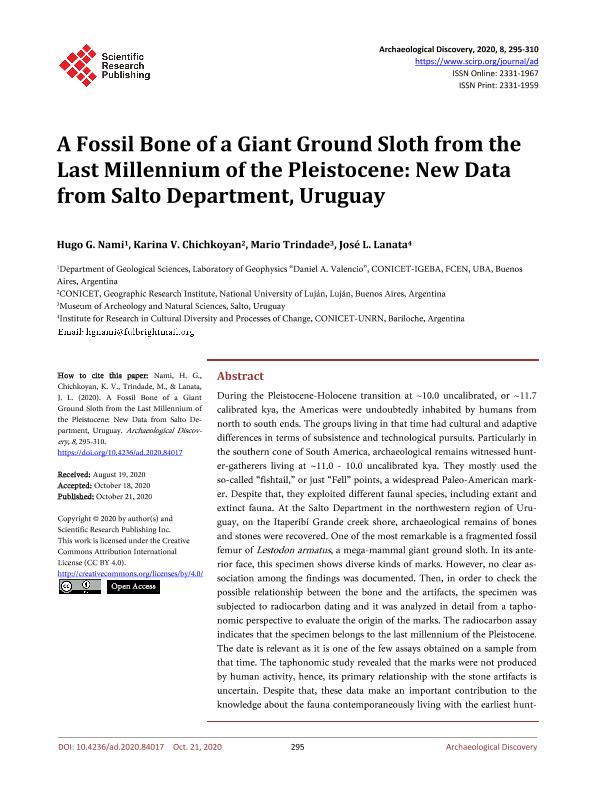Artículo
A fossil bone of a giant ground sloth from the last millennium of the pleistocene: New data from Salto department, Uruguay
Fecha de publicación:
10/2020
Editorial:
Scientific Research Publisher
Revista:
Archaeological Discovery
ISSN:
2331-1959
e-ISSN:
2331-1967
Idioma:
Inglés
Tipo de recurso:
Artículo publicado
Clasificación temática:
Resumen
During the Pleistocene-Holocene transition at ~10.0 uncalibrated, or ~11.7 calibrated kya, the Americas were undoubtedly inhabited by humans from north to south ends. The groups living in that time had cultural and adaptive differences in terms of subsistence and technological pursuits. Particularly in the southern cone of South America, archaeological remains witnessed hunter-gatherers living at ~11.0 - 10.0 uncalibrated kya. They mostly used the so-called “fishtail,” or just “Fell” points, a widespread Paleo-American marker. Despite that, they exploited different faunal species, including extant and extinct fauna. At the Salto Department in the northwestern region of Uruguay, on the Itaperibí Grande creek shore, archaeological remains of bones and stones were recovered. One of the most remarkable is a fragmented fossil femur of Lestodon armatus, a mega-mammal giant ground sloth. In its anterior face, this specimen shows diverse kinds of marks. However, no clear association among the findings was documented. Then, in order to check the possible relationship between the bone and the artifacts, the specimen was subjected to radiocarbon dating and it was analyzed in detail from a taphonomic perspective to evaluate the origin of the marks. The radiocarbon assay indicates that the specimen belongs to the last millennium of the Pleistocene. The date is relevant as it is one of the few assays obtained on a sample from that time. The taphonomic study revealed that the marks were not produced by human activity, hence, its primary relationship with the stone artifacts is uncertain. Despite that, these data make an important contribution to the knowledge about the fauna contemporaneously living with the earliest hunt er-gatherer that were foraging the regional landscape during one of the colonization events that populated the southern cone of South America.
Archivos asociados
Licencia
Identificadores
Colecciones
Articulos(IIDYPCA)
Articulos de INST. DE INVESTIGACIONES EN DIVERSIDAD CULTURAL Y PROCESOS DE CAMBIO
Articulos de INST. DE INVESTIGACIONES EN DIVERSIDAD CULTURAL Y PROCESOS DE CAMBIO
Citación
Nami, Hugo Gabriel; Chichkoyan, Karina Vanesa; Trindade, Mario; Lanata, Jose Luis; A fossil bone of a giant ground sloth from the last millennium of the pleistocene: New data from Salto department, Uruguay; Scientific Research Publisher; Archaeological Discovery; 8; 4; 10-2020; 295-310
Compartir
Altmétricas




